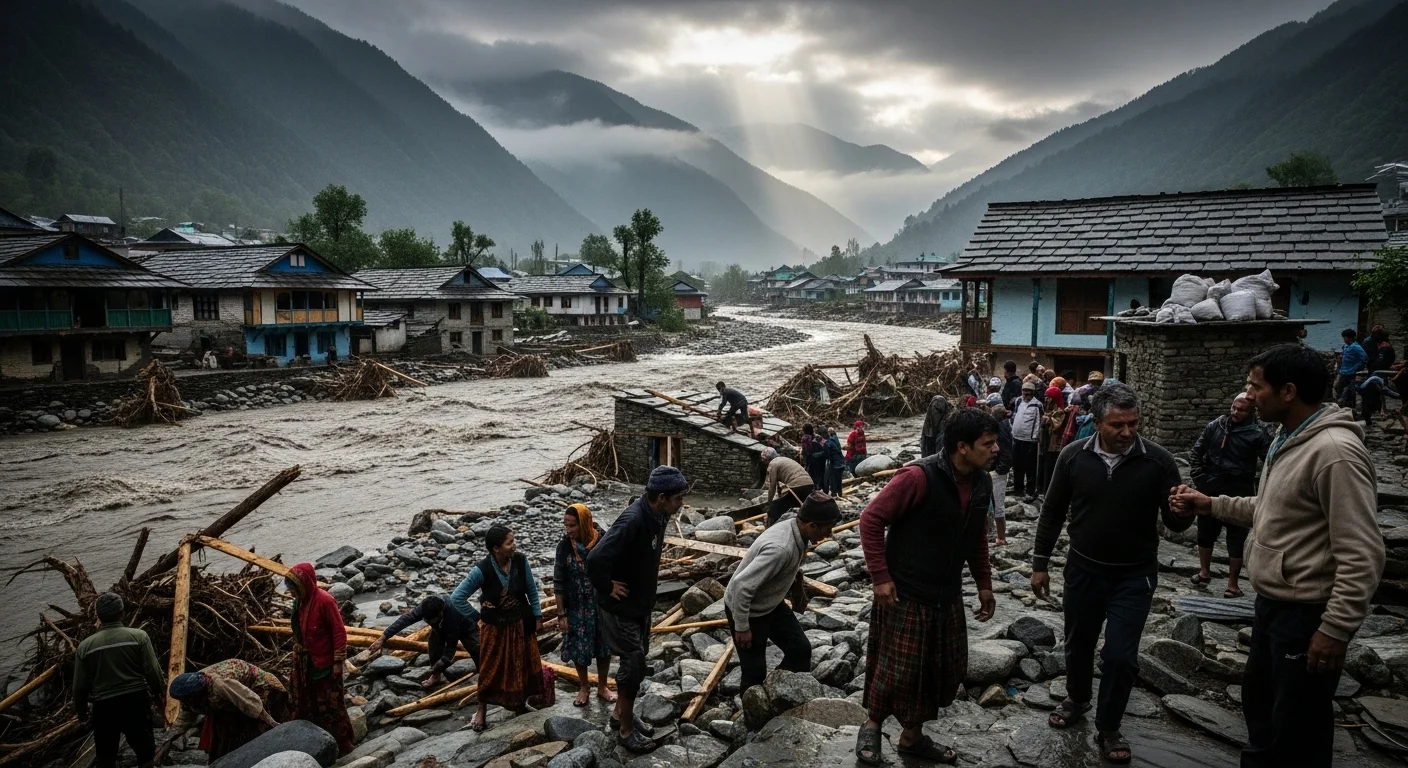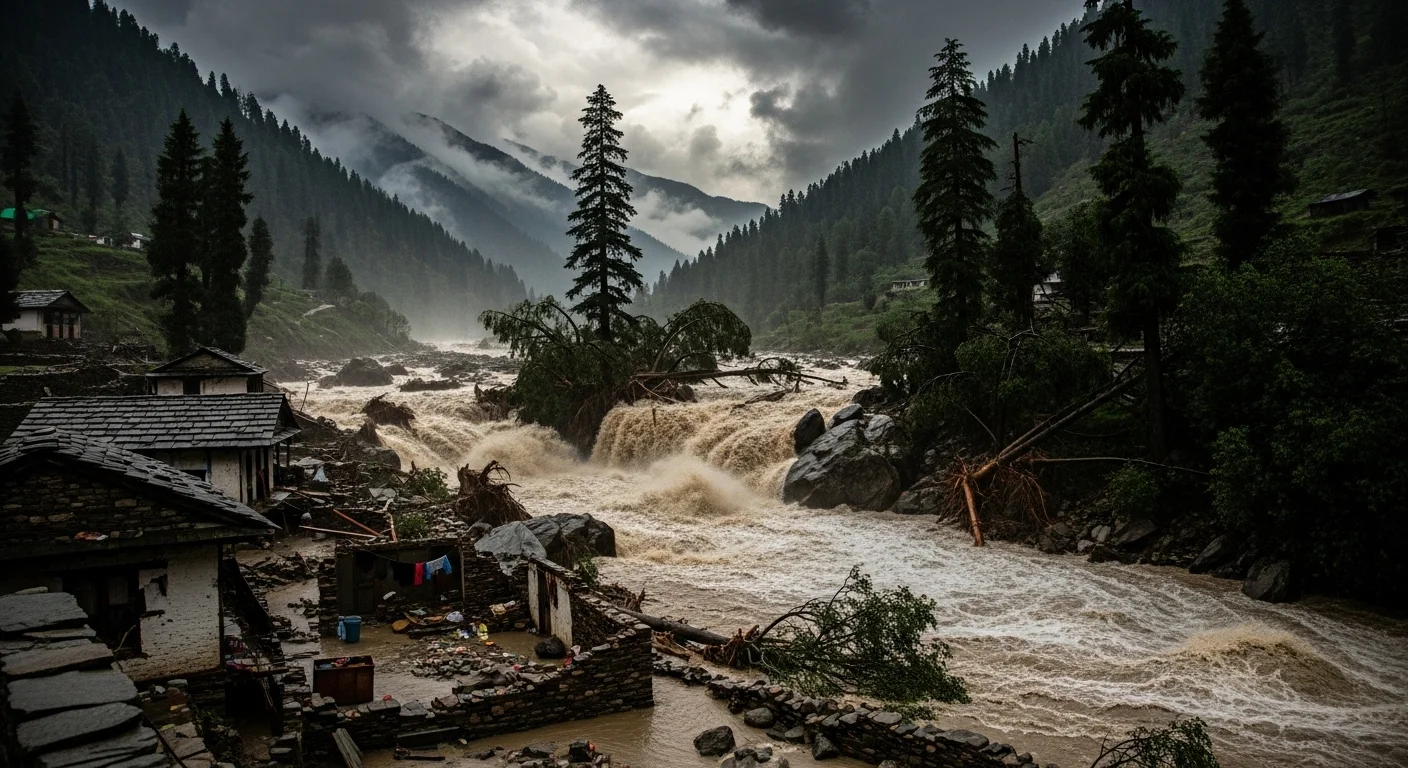Uttarkashi, surrounded by silent hills and lush valleys in Uttarakhand, has always been a land known for its serene beauty and spiritual journeys. But two days ago (flash flood occurred on 5 August 2025, Tuesday), a terrifying event shattered the peace of a small village named Dharali, turning a landscape of lush green into a scene of unimaginable destruction. A sudden and devastating cloudburst struck, and in its wake, it left behind a stark reminder of our changing climate, the fragile Himalayan ecosystem, and the urgent need for better disaster preparedness.
In this post, we’ll take a closer look at what happened in Dharali, the science behind the cloudburst, the heartbreaking damage it caused, and what we can all learn from this tragedy in the Himalayas.
That Fateful Night in Dharali
It started as a typical monsoon night in Uttarkashi in August 2025. But in a matter of minutes, the village of Dharali, near Harsil, was hit by an intense downpour. A gentle rain turned into a torrential flood, and what followed was pure chaos:
-
Flash floods rushed down the mountains, swallowing everything in their path.
-
Massive landslides tore through the hillsides.
-
Roads and bridges were completely swept away, and communication lines went silent.
-
Dozens of homes and precious farmlands were destroyed.
Eyewitnesses described a terrifying, loud roar and a monster-like surge of water that washed away buildings, farms, and years of hard work. The people of Dharali were left isolated, in darkness, and in shock.
The Science Behind the Storm: Why it Happened
A cloudburst is an extreme weather event where more than 100mm of rain falls in a very small area in less than an hour. Cloudbursts are common in mountainous environments such as the Himalayas, especially due to the mountainous terrain forcing moist air to rise and cool rapidly, the severity of this incident in Dharali is linked to a few serious factors:
-
Climate Change: A warming planet means the atmosphere can hold more moisture. This increases the intensity and unpredictability of rainfall, making severe events like this Uttarkashi disaster more common.
-
Deforestation: Trees are a natural barrier against soil erosion. With fewer trees to hold the soil in place, the land becomes far more susceptible to the devastating landslides we saw in Dharali.
-
Unplanned Construction: In the rush to build more roads and tourism infrastructure, proper environmental planning is often ignored. This can destabilize the land, making it an easy target for natural disasters.
Also Read: Essential Tips for Travel During Monsoon in July-August
Effect on Local Community

The damage in Dharali wasn’t just physical; it was deeply emotional. More than thirty homes were either badly damaged or completely gone. The villagers’ primary source of income, their farmland, was wiped out by the floods. Even some centuries-old local temples suffered serious structural damage. Multiple injuries were reported, and a few people remain missing.
Immediate relief efforts were launched by the SDRF (State Disaster Response Force), ITBP (Indo-Tibetan Border Police), and the Indian Army. Helicopters were used to drop essential supplies to stranded locals. It was a race against time to help the most vulnerable.
Infrastructure Failure
The disaster completely cut off connectivity. The Gangotri Highway, a major road for pilgrims and locals alike, faced major landslides, effectively isolating Dharali from neighbouring towns for over 48 hours. Electricity poles fell, mobile towers fell, professionally plunging the area into darkness and cutting it off from communication.
The government is now under pressure to enhance early warning systems and develop weather-resilient infrastructure in such high-risk areas.
Also Read: Heavy Monsoon Alert: Destinations to Avoid Due to Heavy Rains
Environmental Impacts
Dharali is in a fragile ecosystem, and natural hazards like this have drastic impacts on the area’s biodiversity. Landslides destroy habitats and inundate rivers with debris. This one also affects the migratory behavior of birds, and the health of aquatic creatures in the Bhagirathi River.
Environmentalists said these cloudbursts and their consequences are a caution of what is in store if development continues to be unsustainable in the Himalayas.
Also Read: Plan to Visit Uncovering Hidden Gems Perfect for Heavy Monsoon Weather
Government Response and Rehabilitation
The Uttarakhand State Government has responded with several measures:
-
An emergency relief fund of ₹10 crore has been announced.
-
Temporary shelters have been set up for the villagers who lost their homes.
-
Compensation will be provided for those who lost family members.
-
There are plans for soil testing and a major reforestation drive.
Additionally, disaster-resilient housing schemes are being considered for rebuilding efforts. The Central Government has also promised to deploy NDRF (National Disaster Response Force) teams for regular monitoring of the region.
Preventing Future Disasters: What Can Be Done?
To prevent similar disasters from occurring in the future, the following are recommended by specialists:
-
Early Warning Systems: The development and installation of real time weather radar and cloudburst detection systems.
-
Sustainable Development: Moving away from development in ecologically sensitive areas.
-
Reforestation Drives: To plant trees and stabilize soil, which will help with runoff.
-
Public Awareness: Teaching locals about emergency response methods and evacuation protocols.
-
River Management: Building check dams to manage flow in river embankments.
Voices from the Ground:
“There was a loud roar, and then water just came in like a monster. There was nothing we could do to save anything,” said Mohan Rawat, a local resident, and now a family of six living in a tent provided by relief authorities.
There are also local NGOs that have stepped in to provide food, clothing and medicines while mental health professionals have been deployed to help villagers deal with the mental toll from the trauma of the disaster.
Conclusion
The Dharali cloudburst is more than just a natural disaster; it’s a powerful call to action. The villagers of Uttarkashi are resilient, but their homes and livelihoods cannot continue to be scarred by the long-term effects of climate change and a lack of systemic support. This tragedy in Uttarakhand highlights the delicate and often dangerous relationship between human development and nature. By implementing smarter policies and listening to the environment, we can help protect not only Dharali but countless other vulnerable communities in the majestic Himalayas. It’s time to build a future where nature and people can coexist safely.







